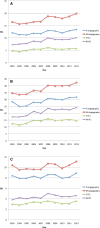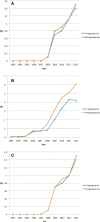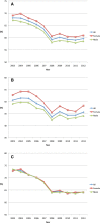Sex-Based Disparities in Incidence, Treatment, and Outcomes of Cardiac Arrest in the United States, 2003-2012
- PMID: 27333880
- PMCID: PMC4937290
- DOI: 10.1161/JAHA.116.003704
Sex-Based Disparities in Incidence, Treatment, and Outcomes of Cardiac Arrest in the United States, 2003-2012
Abstract
Background: Recent studies have shown improving survival after cardiac arrest. However, data regarding sex-based disparities in treatment and outcomes after cardiac arrest are limited.
Methods and results: We performed a retrospective analysis of all patients suffering cardiac arrest between 2003 and 2012 using the Nationwide Inpatient Sample database. Annual rates of cardiac arrest, rates of utilization of coronary angiography/percutaneous coronary interventions/targeted temperature management, and sex-based outcomes after cardiac arrest were examined. Among a total of 1 436 052 discharge records analyzed for cardiac arrest patients, 45.4% (n=651 745) were females. Women were less likely to present with ventricular tachycardia/ventricular fibrillation arrests compared with men throughout the study period. The annual rates of cardiac arrests have increased from 2003 to 2012 by 14.0% (Ptrend<0.001) and ventricular tachycardia/ventricular fibrillation arrests have increased by 25.9% (Ptrend<0.001). Women were less likely to undergo coronary angiography, percutaneous coronary interventions, or targeted temperature management in both ventricular tachycardia/ventricular fibrillation and pulseless electrical activity/asystole arrests. Over a 10-year study period, there was a significant decrease in in-hospital mortality in women (from 69.1% to 60.9%, Ptrend<0.001) and men (from 67.2% to 58.6%, Ptrend<0.001) after cardiac arrest. In-hospital mortality was significantly higher in women compared with men (64.0% versus 61.4%; adjusted odds ratio 1.02, P<0.001), particularly in the ventricular tachycardia/ventricular fibrillation arrest cohort (49.4% versus 45.6%; adjusted odds ratio 1.11, P<0.001).
Conclusions: Women presenting with cardiac arrests are less likely to undergo therapeutic procedures, including coronary angiography, percutaneous coronary interventions, and targeted temperature management. Despite trends in improving survival after cardiac arrest over 10 years, women continue to have higher in-hospital mortality when compared with men.
Keywords: angiography; heart arrest; revascularization; sudden death; women.
© 2016 The Authors. Published on behalf of the American Heart Association, Inc., by Wiley Blackwell.
Figures




Similar articles
-
Sex-Based Differences in 30-Day Readmissions After Cardiac Arrest: Analysis of the Nationwide Readmissions Database.J Am Heart Assoc. 2022 Sep 20;11(18):e025779. doi: 10.1161/JAHA.122.025779. Epub 2022 Sep 8. J Am Heart Assoc. 2022. PMID: 36073654 Free PMC article.
-
Racial and Ethnic and Sex Disparities in the Outcomes and Treatment of In-Hospital Cardiac Arrest: A Nationwide Analysis From the United States.J Am Heart Assoc. 2025 Feb 18;14(4):e038683. doi: 10.1161/JAHA.124.038683. Epub 2025 Feb 19. J Am Heart Assoc. 2025. PMID: 39526496 Free PMC article.
-
Temporal Trends in Incidence and Survival From Sudden Cardiac Arrest Manifesting With Shockable and Nonshockable Rhythms: A 16-Year Prospective Study in a Large US Community.Ann Emerg Med. 2023 Oct;82(4):463-471. doi: 10.1016/j.annemergmed.2023.04.001. Epub 2023 May 18. Ann Emerg Med. 2023. PMID: 37204349 Free PMC article.
-
Cardiopulmonary resuscitation in children.Curr Opin Crit Care. 2009 Jun;15(3):203-8. doi: 10.1097/mcc.0b013e32832931e1. Curr Opin Crit Care. 2009. PMID: 19469022 Review.
-
In-Hospital Cardiac Arrest: A Review.JAMA. 2019 Mar 26;321(12):1200-1210. doi: 10.1001/jama.2019.1696. JAMA. 2019. PMID: 30912843 Free PMC article. Review.
Cited by
-
Sex-Related Differences in Utilization and Outcomes of Extracorporeal Cardio-Pulmonary Resuscitation for Refractory Cardiac Arrest.ASAIO J. 2024 Sep 1;70(9):750-757. doi: 10.1097/MAT.0000000000002210. Epub 2024 Apr 8. ASAIO J. 2024. PMID: 38588589 Free PMC article.
-
Ethnic and sex-based differences in outcomes after out-of-hospital cardiac arrest: a glimpse of the largest municipal healthcare system in the United States.Cardiovasc Diagn Ther. 2023 Feb 28;13(1):1-10. doi: 10.21037/cdt-22-371. Epub 2023 Feb 14. Cardiovasc Diagn Ther. 2023. PMID: 36864966 Free PMC article.
-
Association of Bystander and First-Responder Efforts and Outcomes According to Sex: Results From the North Carolina HeartRescue Statewide Quality Improvement Initiative.J Am Heart Assoc. 2018 Sep 18;7(18):e009873. doi: 10.1161/JAHA.118.009873. J Am Heart Assoc. 2018. PMID: 30371210 Free PMC article.
-
Short-term and intermediate outcomes of cardiogenic shock and cardiac arrest patients supported by venoarterial extracorporeal membrane oxygenation.J Cardiothorac Surg. 2021 Oct 9;16(1):290. doi: 10.1186/s13019-021-01674-w. J Cardiothorac Surg. 2021. PMID: 34627305 Free PMC article.
-
Targeted temperature management in cardiac arrest patients with a non-shockable rhythm: A national perspective.Am Heart J. 2020 Jul;225:129-137. doi: 10.1016/j.ahj.2020.04.023. Epub 2020 May 3. Am Heart J. 2020. PMID: 32485327 Free PMC article.
References
-
- Centers for Disease Control and Prevention . 2013 cardiac arrest registry to enhance survival (CARES) national summary report. Available at: https://mycares.net/sitepages/uploads/2014/2013CARESNationalSummaryRepor.... Accessed November 11, 2015.
-
- Rosamond WD, Chambless LE, Folsom AR, Cooper LS, Conwill DE, Clegg L, Wang CH, Heiss G. Trends in the incidence of myocardial infarction and in mortality due to coronary heart disease, 1987 to 1994. N Engl J Med. 1998;339:861–867. - PubMed
-
- Vaughan AS, Quick H, Pathak EB, Kramer MR, Casper M. Disparities in temporal and geographic patterns of declining heart disease mortality by race and sex in the United States, 1973–2010. J Am Heart Assoc. 2015;4:e002567 doi: 10.1161/JAHA.115.002567. - DOI - PMC - PubMed
Publication types
MeSH terms
LinkOut - more resources
Full Text Sources
Other Literature Sources
Medical

